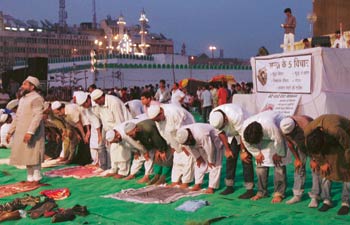Tripti Lahiri
Newspapers in recent days have carried heart-warming pictures of Muslim men praying in front of the stage where anti-corruption activist Anna Hazare has been fasting since last week.
One paper carried a report about Muslims “shedding Anna apathy,” which included an account of a young Muslim girl offering to share her food with Mr. Hazare — he smiled but declined to eat, the news report said.
But although news reports say the Hazare-led corruption movement is making overtures to different groups after it was criticized for not being inclusive, some Muslims and Dalits, members of “untouchable” communities that were traditionally at the bottom of India’s caste hierarchy, say they still feel excluded.
In a piece in the Hindustan Times newspaper on Monday, Harsh Mander, a member of a policy advisory council chaired by Congress Party chief Sonia Gandhi, quoted a Dalits rights activist’s criticism of the Lokpal Bill movement.
“It is an upper caste, middle class movement and it addresses their issues – such as bribes paid to the police or at passport offices,” Arun Khote told Mr. Mander. “How many SC/STs dare to file cases in police stations? Barely 5% cases are filed and 92% are acquitted. In such a situation, how can a lokpal be of any use to the Dalits?” The abbreviations “SC” and “ST” refer, respectively, to scheduled castes and scheduled tribes — groups named in the Constitution as particularly in need of government help in order to overcome historic discrimination.
Some commentators questioned how inclusive Mr. Hazare’s movement was as early as April, when the activist, who models himself on Mahatma Gandhi first fasted to put pressure on the government to move forward on legislation to create a corruption ombudsman. At that time, Mr. Hazare complimented Gujarat’s Chief Minister Narendra Modi for his rural development efforts.
Mr. Modi is a controversial figure because of his hawkish Hindu nationalism, and because some of the deadliest sectarian riots in recent years took place in his state in 2002, when he was already in power. Human rights groups have accused him of telling police to stand down as Hindu mobs rampaged through Muslim neighborhoods to avenge the killing of Hindus in an arson attack on a train. Mr. Modi has denied doing so.
It didn’t help Mr. Hazare’s secular credentials that during his fast in April he was seated in front of a banner that showed a pink-cheeked Hindu goddess imposed over a map of India, an image that dwarfed the pictures of Mahatma Gandhi and other freedom leaders also displayed.
Congress party members were quick to seize upon that to suggest that the protest movement was a front for the Hindu nationalist Bharatiya Janata Party, India’s main opposition party, or for right-wing Hindu groups. Activists have denied this.
Mr. Hazare has been responsive to the criticism. In May he criticized the level of corruption in Gujarat after visiting the state and this time around he’s seated in front of a large image of Mahatma Gandhi, sans goddess.
Speaking on Tuesday, Mr. Hazare tried to counter some of the doubts being raised about his stance on religion and caste.
“I feel very sad people are writing in the papers, I’m told, that in my village, Dalit people don’t have respect or rights,” said Mr. Hazare. He recounted, in his homespun way, how in his village, which he helped develop economically by taking a hard stance on drinking and introducing rainwater harvesting, families had voluntarily worked on the land of Dalit families to help them repay debts.
“We wed in one wedding hall, we eat in one place,” said Mr. Hazare. “This work is very important; we have to end untouchability. Hindu, Muslim, Sikh and Christian, we have all come together to build the nation, starting from the village.”
The website of India Against Corruption, the group behind Mr. Hazare, says it has the backing of Christian and Muslim figures, as well as Hindu ones. But still, people wonder.
The imam of Delhi’s Jama Masjid, Syed Ahmed Bukhari, told India Today magazine that Mr. Hazare “could at least have met some leaders of the minority community and made references against communalism to make his campaign look more inclusive.”
Several commentators have also noted that there continues to be a religious component to the protest – with activists on the dais chanting devotional Hindu songs, including Mahatma Gandhi’s favorite Hindu hymn.
Among the popular slogans in recent days has been “Vande mataram,” or Hail the Motherland, a slogan used during Indian’s Independence struggle that comes from a poem by Bengali writer Bankim Chandra Chatterjee. In the poem, Durga, the goddess of female power, symbolizes the nation, who is also sometimes personified as “Mother India.”
The poem was in the running to be India’s national anthem but the work of another Bengali writer– Rabindranath Tagore’s “Jana Gana Mana” – was deemed to better reflect India’s religious, cultural and geographic plurality.
Civil rights activist Anand Teltumbde, who has written about atrocities against Dalits in Maharashtra, said that the slogans being shouted were reminiscent of those used by a right-wing Hindu group known as the Rashtriya Swayamsevak Sangh (National Volunteers Group) – which is why Dalits and Muslims are wary.
“This nationalist jingoism is very famously associated with the Sangh family,” said Mr. Teltumbde, who is a member of the Mumbai-based Committee for the Protection of Democratic Rights, and who is the grandson of B.R. Ambedkar,the most respected Dalit icon bar none. “That tone, tenor and the slogans reinforce the belief that ‘this is not ours.’”
The movement is also problematic for Dalits on another level, Mr. Teltumbde noted: Mr. Ambedkar, India’s first law minister and the main author of its Constitution, was famously against Gandhi-style hunger strikes and emotionally coercive methods to bring about change.
Source: WSJ





















